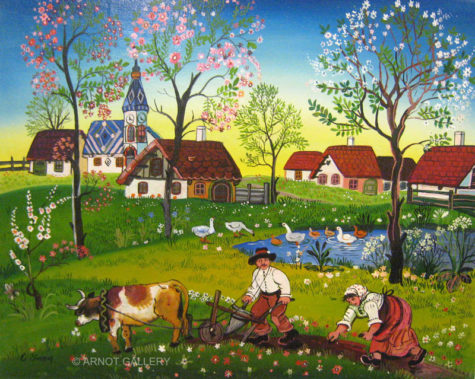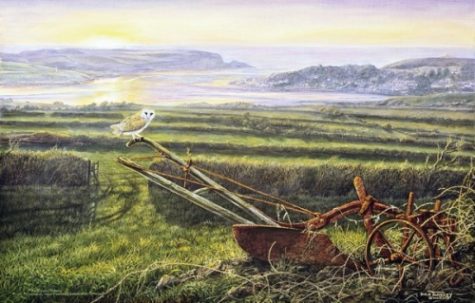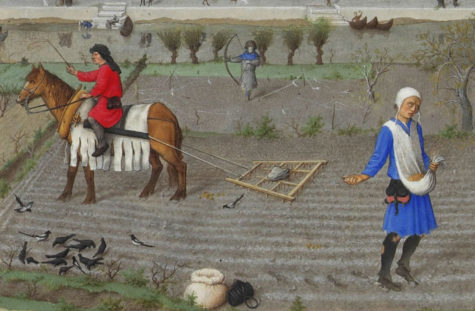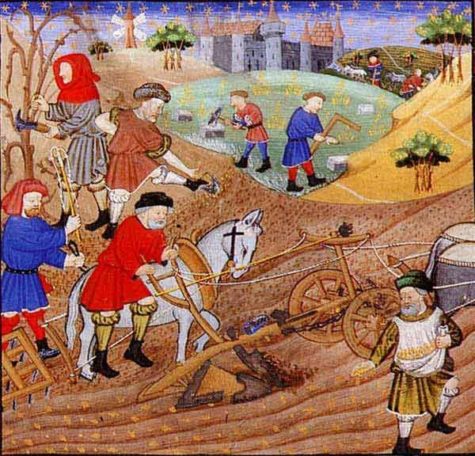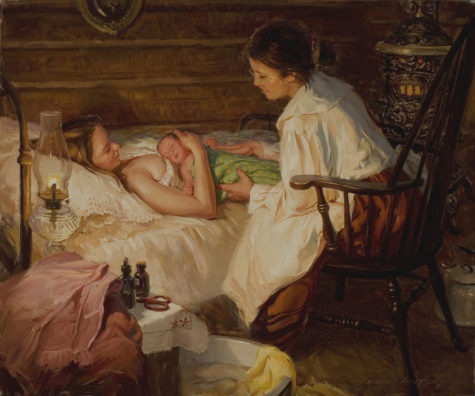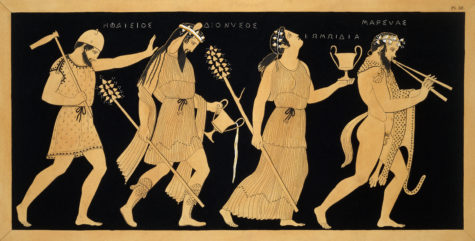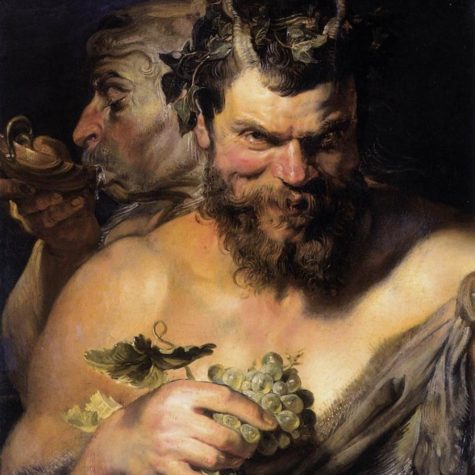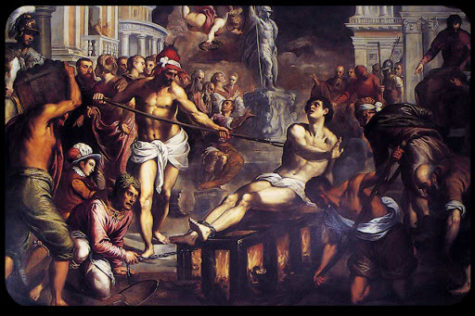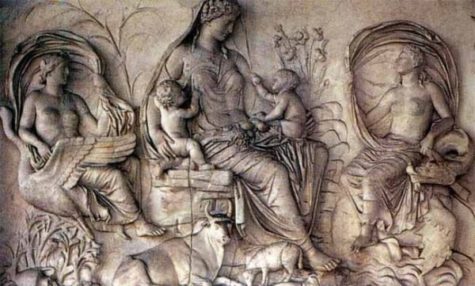Fertility
Kalevala Day is celebrated in Finland on 28 February, to match Elias Lönnrot’s first version of The Kalevala in 1835. It is an official flag-raising day in Finland, and simultaneously the Day of Finnish culture. The epic poem, Kalevala is celebrated by the Finns with parades and readings from the poem.
- Themes: Creativity; Tradition; Fertility; Beginnings
- Symbols: Egg; East Wind: Poetry
- Presiding Goddess: Luonnotar
About Luonnotar:
A Finno-Ugric creatrix, Luonnotar closes the month of February with an abundance of creative, fertile energy. Her name means “daughter of earth,” and according to legend she nurtured the cosmic eggs from which the sun, moon, and stars developed. In the Kalevala, Luonnotar is metaphorically represented as the refreshing east wind – the wind of beginnings. She also created the first bard, Vainamolen.
To Do Today:
The Kalevala is the epic poem of more than twenty thousand verses that recounts the history and lore of the Finnish people. Luonnotar appears in the creation stanzas, empowering the entire ballad with her energy. If there’s anything in your life that needs an inventive approach or ingenious nudge, stand in an easterly wind today and let Luonnotar’s power restore your personal muse. If the wind doesn’t cooperate, stand instead in the breeze created by a fan facing west.
To generate fertility or internalize a little extra resourcefulness as a coping mechanism in any area of your life, make eggs part of a meal today. Cook them sunny side up for a “sunny” disposition, over easy to motivate easy transitions, or hard boiled to strengthen your backbone!
Another way to celebrate the day would be with a reading from the Kalevala, some of which can be found at Widdershins – just search the tag: Kalevala. There is also a nice Finnish Healing Spell adapted from the Kalevala on Book of Shadows
From: 365 Goddess
- Time: Early to Mid-February, Normally Observed at First New Moon
- Focus: Disir, Goddesses and The Beginning of the Planting Season
- Overall: A time to honor the Disir (in a broad sense), Goddesses and those connected with the coming power of Spring – the Vanir, local land wights and Nerthus to name a few examples.
The Charming of the Plough, also referred to as Éowemeolc is the Anglo-Saxon early spring or pre-spring festival. It was clearly so early as to be more about seeing signs of spring than celebrating its arrival. The early date serves the purpose of doing the blessing before there is any danger of cultivation starting without it.
Charming of the Plow is a ceremony that marks the beginning of the planting season; when the first furrows are made in the fields. In the Old World that usually meant bonding with and asking for the blessing of Gods and Goddess, the local land spirits and perhaps anyone else who might help insure the crops are a success.
The Vanir, Nerthus and land wights are thus honored at this time for the coming Spring and to wish a healthy season for the crops. Farm tools are blessed and an offering of bread and mead/milk are traditionally given to the land wights upon the first furrows made into the earth. Even as a home gardener I like to do this each year.
Disting (Old Swedish: thing at the time of the sacrifice to the Disir~ which are female ancestral guardian spirits), is still modernly observed as an annual market in Upsalla, Sweden. Traditionally, it was a time when many would gather for the Thing of All Swedes, hold a great market and a special blot at the temple in Upsalla for the Disir.
Recorded as a regular feast only in Sweden, this blessing takes place in early or mid-February. The name means ‘Thing (assembly) of the Goddesses’. In Sweden, it was the first public moot/fair of the year; in Denmark, this is the time when the first furrows were ploughed in the field (an activity much hedged about with folk custom). This is a feast of new beginnings, at which the work of the year to come is blessed. this time, the Earth is prepared to have the seeds sown so that growth will take place in the land. Also, gifts may be given to the disir and elves at this time.
Dating The Blessing
Since the Icelandic months had become fixed, while the Anglo-Saxon months were fully lunar, it may not be possible to determine whether the blessing of the plow or earliest harbinger of spring festival was held at the same time in all Germanic areas—tied to the time of Yule—or whether it depended on local agricultural conditions, such as the beginning of lambing or the first partial thaw of the new year.
Whatever the traditional date for Blessing of the Plough, whether January or February, it would be in late winter or very early spring, well before an outsider might expect the first furrow to be cut.
These days we usually celebrate Éwemeolc/Blessing of the Plough on February 2—to coincide with the Celtic Imbolc, and because it is a cross quarter day, midway between Yule and Eostre/Ostara. This is the source of the American Groundhog Day celebration, because the spring equinox is 6 weeks away.
About the Name:
The Anglo-Saxon name refers to ewes (female sheep) giving milk because they have birthed their lambs. The Anglo-Saxons got much of their milk from sheep. This holy day has several names and several possible spellings. First and most obviously, “plough” is normally “plow” in the US. Other names include:
- Éowemeolc
- Éwemeolc
- Ewemeoluc
The second month of the Anglo-Saxon year, corresponding roughly to February was called Sólmónað. Bede writes: “Solmónaþ can be called the month of cakes, which [the Angles] offered to their gods during it.” However, no such word sol or sól is recorded in Anglo-Saxon, so some scholars think the month was actually named after the sun, but the sun is sunne in Anglo-Saxon.
So the other theory is that the month-name actually comes from sulh, “plough.” The cakes are presumed to have been offered by leaving them in the furrows; they may have been called “plough-cakes.”
This is one of the reasons modern Anglo-Saxon heathens celebrate Blessing of the Plough at this time. The other is that plows have clearly been blessed (or charmed) in England since at least Anglo-Saxon times.
About the Blessing:
This is a syncretistic charm—a melding of Christian and heathen elements—intended to cause a barren field to grow a good crop, or to reverse a spell that has been placed on the field. It also seems clear that blessing the plow and using it to cut the first furrow and then wetting it with a special milk mixture—which would presumably be ewe’s milk—relate as much to starting off any agricultural year in the best way possible as to reversing a curse.
The Field Blessing Charm:
Here is the remedy, how you can improve your fields if they do not want to grow well or when some harmful thing has been done to them by a wizard or poisonous sorcery. Take then at night, before dawn, four sods from four parts of the land and mark how they were before.
Take then oil and honey and yeast, and milk from each kind of livestock that may be on the land, and a piece of each kind of tree that may grow on the land, except for “hard trees”, and a piece of each plant / herb known by name except for glappan (burdock) alone, and then put holy water theron, and then drip it thrice on the base of the sods, and then speak these words:
Crescite, grow, and multiplicamini, and multiply,
et replete, and fill, terre, the earth.
In nomine patris et filii et spiritus sanctu sit benedicti.
And the Pater Noster as often as the other one. And after that, carry the sods to church, and a mass-priest should sing four masses over the sods, and one should turn the green side towards the altar, and afterwards one should take the sods to where they were previously, before the setting of the sun.
After this, four crosses are made from branches, inscribed with the evangelists names, and buried face-down in the pits from which the sods were taken.
When all that is done, then let someone take unknown seed from beggars and give them twice as much as he took from them, and let him gather all his plowing gear together; then bore a hole into the plow beam putting into it incense and fennel and hallowed salve and hallowed salt. Then take that seed, place it on the body of the plow, then say:
Erce, Erce, Erce, mother of the earth,
may the almighty grant you, the eternal lord,
fields growing and flourishing,
increasing and strengthening,
high shafts, bright fruits,
and the abundant barley-growth,
and the white wheat-growth,
and all growth of the earth
May the etrnal lord grant him,
and all his holy ones, who are in heaven,
that his produce may be defended against all enemies,
and that it be protected against all evils,
against poisonous sorceries sown over the land.
Now I ask that the ruler, he who shaped this orld,
that there may be no speaking-woman or a skilful man
who can turn to naught words thus spoken
Then let someone drive forth the plow and open the first furrow: then say:
May you be well, earth, mother of men!
May you grow in God’s embrace,
filled with food for use by men.
The original text of the charm may be found here: Metrical Charm For Unfruitful Land
Sources:
Called Feriae Sementivae, this one or two day Roman festival was moveable, but generally began between January 24 and January 26. Sacred to Tellus, and Ceres, this festival was for the protection of seeds, either those sown the previous fall, or those to be sown in the spring. During Sementivae plowing oxen were decorated with garlands, and puppets or masks were hung from tree branches.
This is an excellent time to begin to think about planting a “Witch’s Garden” and to do spellwork involving seeds. Spiritually and metaphysically, this is an optimum time to sow the internal seeds of what we hope to bring forth as the year unfolds.
The ancients honored their midwives today (January 8) as the goddess’s assistants by giving them gifts. In modern times, this might equate to sending a thank-you note to your physician or pediatrician.
- Patron Goddess: Eleithyia
- Themes: Birth; Children; Creativity; Fertility
- Symbols: A Torch; White Flowers
About Eleithyia:
As the aegean goddess of birth, Eleithyia acts as the midwife to your new year, filling it with creative power. Eleithyia’s name translates as “Fluid of Generation,” giving her strong fertile aspects, and she also has a hand in personal fate.
According to myth, Eleithyia was the midwife of the gods and even birthed Eos, the creative force behind all things. When Eleithyia’s hands were closed, birth was delayed. When Eleithyia opened her body, a child arrived effortlessly.
For more information on this goddess, visit Eleithyia on The Powers That Be.
To bring Eleithyia’s fertility to any area of your life, try this spell:
Gather a handful of white flower petals. Work in an area that somehow represents your goal. If you want a fertile garden, for example, cast this spell in your garden; for fertile ideas, perform it in your study. Visualize your goal as you release all but one petal, turning clockwise to the winds, saying:
The wish of my heart, Eleighyia see,
and bring back to me fertility.
Carry the last petal to help the magic manifest.
Source: 365 Goddess
The Dionysia was originally a rural festival in Eleutherae, Attica, probably celebrating the cultivation of vines. It was probably a very ancient festival, perhaps not originally associated with Dionysus. This “rural Dionysia” was held during the winter, in the month of Poseideon (the month straddling the winter solstice, Dec – Jan).
The central event was the procession (pompe), in which a symbol of the phallos, sign of fertility, was carried through the dancing and singing procession. Young girls carried baskets, others carried long loaves of bread and other offerings, also carried in the procession were jars of water and wine. The pompe ended with a sacrifice consisting of baked bread or a gruel of cereal.
After the pompe procession was completed, there were contests of dancing and singing, and choruses (led by a choregos) would perform dithyrambs. Some festivals may have included dramatic performances, possibly of the tragedies and comedies that had been produced at the City Dionysia the previous year. This was more common in the larger towns, such as Piraeus and Eleusis. Generally, it was a joyful festival, shared by all, even the slaves.
Because the various towns in Attica held their festivals on different days, it was possible for spectators to visit more than one festival per season. It was also an opportunity for Athenian citizens to travel outside the city if they did not have the opportunity to do so during the rest of the year. This also allowed travelling companies of actors to perform in more than one town during the period of the festival.
The City Dionysia. also known as the Great Dionysia, was the urban part of the festival, possibly established in the 6th century BC. This festival was held probably from the 10th to the 16th of the month Elaphebolion (the lunar month straddling the vernal equinox, Mar – Apr in the solar calendar), three months after the rural Dionysia, probably to celebrate the end of winter and the harvesting of the year’s crops.
Ways to celebrate in modern times:
Sing, dance, play games, attend or participate in a parade or comedic theater of some sorts. Create phallic-shaped cakes for consumption and sacrifice. Read The Archanians by Aristophanies, which provides a glimpse of the festival. Display images and symbols of the God. Recite Orphic Hymns, Homeric Hymns, (all to Dionysos), or even hymns of your own creation.
I celebrate the Rural Dionysia following immediately the Heliogenna lasting through January 1. I pack baskets with gifts of nuts, wine, silly games and gifts, and DVD’s of comedies. Then I deliver those baskets, not more than one a day or evening, to friends and family. I spend the evening with the basket recipient and we eat the snacks, watch the DVDs, and drink the wine.
We also play the silly games and laugh. You don’t have to give the DVDs, you could just bring over a bottle of wine and a DVD from your collection or a netflix. That’s how I celebrate it since that is pretty close (in spirit) to what the Rural Dionysia was all about. – Cara Schulz
The Ancient Hymns
- The Fumigation from Storax.
Bacchus I call, loud-sounding and divine, fanatic God, a two-fold shape is thine: Thy various names and attributes I sing, O, first-born, thrice begotten, Bacchic king: Rural, ineffable, two-form’d, obscure, two-horn’d, with ivy crown’d, euion, pure. Bull-fac’d, and martial, bearer of the vine, endu’d with counsel prudent and divine: Triennial, whom the leaves of vines adorn, of Jove and Proserpine, occultly born. Immortal dæmon, hear my suppliant voice, give me in blameless plenty to rejoice; And listen gracious to my mystic pray’r, surrounded with thy choir of nurses fair.
- A Hymn
Come, blessed Dionysius, various nam’d, bull-fac’d, begot from Thunder, Bacchus fam’d. Bassarian God, of universal might, whom swords, and blood, and sacred rage delight: In heav’n rejoicing, mad, loud-sounding God, furious inspirer, bearer of the rod: By Gods rever’d, who dwell’st with human kind, propitious come, with much-rejoicing mind.
- The Fumigation from Manna.
Liknitan Bacchus, bearer of the vine, thee I invoke to bless these rites divine: Florid and gay, of nymphs the blossom bright, and of fair Venus, Goddess of delight, ‘Tis thine mad footsteps with mad nymphs to beat, dancing thro’ groves with lightly leaping feet: From Jove’s high counsels nurst by Proserpine, and born the dread of all the pow’rs divine: Come, blessed pow’r, regard thy suppliant’s voice, propitious come, and in these rites rejoice.
- The Fumigation from Aromatics.
Bacchus Pericionius, hear my pray’r, who mad’st the house of Cadmus once thy care, With matchless force, his pillars twining round, (when burning thunders shook the solid ground, In flaming, founding torrents borne along), propt by thy grasp indissolubly strong. Come mighty Bacchus to these rites inclin’d, and bless thy suppliants with rejoicing mind.
- To Dionysus
Of ivy-tressed uproarious Dionysus I begin to sing, the splendid son of Zeus and renowned Semele. Him did the fair-tressed nymphs foster, receiving him from the king and father in their bosoms, and needfully they nurtured him in the glens of Nysê. By his father’s will he waxed strong in the fragrant cavern, being numbered among the Immortals. Anon when the Goddesses had bred him up to be the god of many a hymn, then went he wandering in the woodland glades, draped with ivy and laurel, and the nymphs followed with him where he led, and loud rang the wild woodland. Hail to thee, then, Dionysus of the clustered vine, and grant to us to come gladly again to the season of vintaging, yea, and afterwards for many a year to come.
Sources: Wikipedia, Hellenionstemenos, and Project Gutenberg
When told by Roman officials to surrender the church’s valuables, St. Lawrence brought the city’s poor and sick. “Here is the church’s treasure,” he said.
Rome didn’t find this amusing, and legend says he was put to death in A.D. 258 by being roasted on a grate, although some scholars say he was more likely beheaded. In either case, folks in southern Europe still mark this day.
- It is customary there to eat only cold meat in recognition of the reputed manner of his death.
- Fair weather on St. Lawrence’s Day presages a fair autumn.
To do on Saint Lawrence’s Day:
Tonight, or especially tomorrow night and up to the dawn of August 12, if you look up at a clear sky in the Northern hemisphere, you may be blessed to see the Perseids meteor shower. This meteor shower is known as “the tears of St. Lawrence” because it is most visible at this time of year, though these streaks of light can sometimes be seen as early as 17 July and as late as 24 August.
To see St. Lawrence’s “fiery tears,” go outside after midnight, to a place as far away as possible from city lights (leave the city, if possible, and drive toward the constellation so that the city lights’ glow will be behind you). Lie down on the grass and look up and toward the North, about halfway between the constellation Perseus 3 — which will be very, very low on the horizon to the northeast — and the point directly overhead. Scan the sky elsewhere, too, but this area will be the most likely place to see the meteors.
If the sky is too cloudy or the Moon is too full for you to get a good view of the stars, you might not have any luck at all — but there will always be next year to try again!
When you see a “shooting star,” make a wish, as folklore says that wishes made when seeing such a star come true. Better yet, make the “wish” a prayer, and invoke St. Lawrence to pray it with you!
The darkness is no darkness with me,
but the night is as clear as the dawning,
that shineth more and more unto the perfect day.
~Saint Lawrence
As to foods, aside from the European custom of eating only cold meat, there is nothing else in particular associated with this day that I am aware of. However, given St. Lawrence’s mode of death, a barbecue might make for an interesting choice. Grill some meats and vegetables, have a nice cooler of beer, and prepare for a late night of star-gazing and recalling the glory of St. Lawrence! Continue reading
On April 15th, every year, the Ancient Romans held the festival of Fordicia, also called Hordicidia. This festival was in honor of Tellus, or Terra Mater, the Roman personification of the earth.
Terra Mater or Tellus Mater was a goddess personifying the Earth in Roman mythology, with both names meaning “Mother Earth” (a common metaphorical expression for the Earth and its biosphere as the giver and sustainer of life) in Latin. She was associated with Ceres in respect to growing crops, was responsible for the productivity of farmland, and was also associated with marriage, motherhood, pregnant women, and pregnant animals. Her Greek counterpart is Gaia.
During the festivities, a pregnant cow was sacrificed, the calf fetus burned and the ashes saved for the Parilia festival (an agricultural festival performed annually on April 21). The whole event was governed by the Vestal Virgins and the Pontifex Maximus.
The purpose of the sacrifice was to assure the fertility of the planted grain already growing in the womb of Mother Earth in the guise of Tellus, to whom the sacrifice was offered. As with certain other rituals over which the Vestals presided, the unborn calf is a liminal or mediating being: not yet born, but living; not a full-fledged victim, but sacrificed. The role of the Vestals emphasizes their importance in linking through the ritual reuse of elements the Earth’s fertility, the health and safety of the flocks, and the security of the city, including and especially its military security against invasion.
A similar spring festival in China was witnessed in 1804 by the British ambassador to China, John Barrow. At the temple of Earth, a large porcelain cow was carried in procession then shattered to reveal several small cow-images inside. These were distributed among the people as tokens of a good growing season. Fowler speculated that the Chinese rite was in origin an animal sacrifice similar to that of the Fordicidia.
A Ritual For Tellus Mater
- Color: Green
- Element: Earth
- Offering: Go outside the community and find land to clean up.
- Daily Meal: Vegetarian
Altar: Upon a green cloth place several large stones of different sorts, some in a clay bowl of water; a clay bowl of salt, a loaf of thick, nourishing black bread with herbs and vegetable gratings in it, a chalice of herbal tea, boughs of greenery, and four green candles.
Invocation to Tellus Mater
Our Mother lies beneath our feet
And holds up our every step.
There is nowhere that we can walk
Where She does not lie beneath us.
There is nothing that we can eat
That will nourish our bodies,
Those bodies that are made from Her clay,
That does not come from Her
And Her other children.
We are born of Her
As we are born of woman,
Each and every one of us.
No matter who we are,
No matter where we walk,
No matter what we think,
We are still Her children.
Hail, Mother of All Things!
Hail, bounteous one, giver of life,
And taker of life back into your breast.
From you we all proceed
And to you we shall all return.
Chant:
The Earth is our mother, we must take care of her,
The Earth is our mother, we must take care of her,
Hey and a ho and a ho na na
Hey and a ho and a ho na na
(All join hands while chanting and move in a spiral dance around the room, four times in and out. Then the bread and tea is passed around. It is important that much work be done on the Earth today, both in and out of the community’s land.)
Sources:
The full moon in February is known as the Quickening moon, it marks the official end of winter, and the quickening, the renewal of all things. While the skies are still gray, and the weather is cold, beneath the surface life begins to secretly stir.
This moon phase is a time of abundance, ripening and completeness, heavy with fertility and female divinity. It is a time when the potential of all things begins to stir towards birth in spring, a time to work on our own inner power and confront personal truths in preparation for birth. This moon sheds enough light to help us see into our darkness, so that our energy can make its way to the surface to prepare for growth and healing.
This is the season of Imbolc, the days when we know that if we can just hold on for a few more weeks, we might get lucky and see little green shoots peeking out through the snow and slush.
Correspondences:
- Colors: Purple and blue
- Gemstones: Rose quartz, amethyst, jasper
- Trees: Rowan, Myrtle
- Gods: Brighid, Aphrodite, Juno, Mars
- Herbs: Hyssop, sage, myrrh
- Element: Fire
The word Quickening is also used to describe the first moment in pregnancy when a woman feels the movements of her baby. So too, this a time when new life is beginning, but still lies dormant. Pregnant animals, due in the spring, begin to feel the quickening of their unborn young. The earth itself is quickening, as seeds and bulbs far beneath the soil begin their journey towards the light. We know these things are coming — and we know also that this is a good month to make plans for the future. We can dream and hope, and set goals for ourselves. Accept responsibility for mistakes you’ve made in the past, and move on.
Magical workings this month should focus on personal achievements and advancement. This is an excellent time for fertility and childbirth spells.
From various sources

